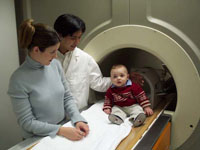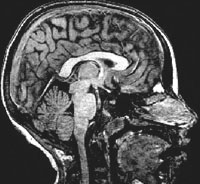Archived Content
The National Institute of Mental Health archives materials that are over 4 years old and no longer being updated. The content on this page is provided for historical reference purposes only and may not reflect current knowledge or information.
Kids’ Brain Development Charted as They Grow Up
First MRI Data Release on Young Children, Brain Chemistry
• Science Update

A landmark, multisite NIH-funded neuroimaging study of brain development in healthy, normally-developing children has posted its third release of data. This is the first release from the magnetic resonance imaging (MRI) study to include data from very young children — birth to 4 years old — and snapshots of brain chemistry at key developmental milestones. The data is accessible to qualified researchers via the NIH Pediatric MRI Data Repository website.
Data Sharing Infrastructure
Increasingly, NIH-funded researchers are being encouraged to share their raw data — not just report their research findings in journals. To facilitate this, data sharing infrastructure is being created in certain fast-developing fields. For example, to optimize use of burgeoning knowledge about autism, NIMH is leading a multi-Institute effort to develop a National Database for Autism Research (NDAR). Through this web resource, the broad autism research community will exchange data, tools, and other research-related information.
Similarly, through its data repository, the multi-institute NIH Pediatric Magnetic Resonance Imaging (MRI) Study of Normal Brain Development is sharing scan data and clinical/behavioral measures from a representative sample of healthy, typically-developing children, and providing researchers access to shared image processing tools. The study collected data between 2001 and 2007 from more than 500 children, spanning infancy to young adulthood, at 3-10 time points. Data is being released in stages.
Third Data Release
The third data release includes longitudinal imaging and clinical/behavioral data for children ages 7 days to young adult. MRI scan data is accompanied by corresponding data from physical neurological examinations, behavioral ratings, neuropsychological testing, structured psychiatric interviews, and hormonal measures from urine and saliva samples. This is the first release to include data from a technique called MR spectroscopy, a type of MRI scan that measures the levels of certain bi-products of metabolism that can be used to gauge the health of brain tissues.
Qualified researchers may apply for access to the data or obtain additional information by email.
Significance
"These data-sharing efforts reflect a new approach to science," explained Judith Rumsey, Ph.D., of NIMH who helped coordinate the study. "The database can be used to chart normal developmental trajectories in order to identify deviations in milestones associated with disease. Differences between boys and girls and relationships to cognitive and behavioral development can be used to understand individual differences or normal variability. As a reference dataset, it can be used to determine normative relationships between various parameters, such as brain size, cortical thickness, the brain's long-distance fiber tracts or connections and the neurochemistry of brain structures throughout development. This in turn will enable researchers to better understand such relationships in disorders such as autism. Where differences in brain size are associated with a disorder, e.g. early overgrowth in autism, researchers will be able to investigate which features of brain structure and function normally are associated with large brains vs. which are indicative of pathology."
What's Next?
Future releases will include data on the thickness of the brain's cortex, or outer mantle, and long distance connections, as measured by a technique called diffusion tensor imaging (DTI). The MRI resource will also be closely linked to NDAR, allowing researchers to readily compare data between these two unique data repositories.

The Pediatric MRI Study of Normal Brain Development was sponsored by four NIH Institutes: the Eunice Kennedy Shriver National Institute of Child Health and Human Development (NICHD), Lisa Freund., the National Institute on Drug Abuse (NIDA), Laurence Stanford,. and Karen Sirocco., the National Institute of Mental Health (NIMH), Judith Rumsey, Ph.D. the National Institute of Neurological Disorders and Stroke (NINDS), Katrina Gwinn-Hardy. Participating sites included Boston Children's Hospital (Principal Investigator [PI] Michael J. Rivkin), Children's Hospital Medical Center of Cincinnati (PI William S. Ball), Children's Hospital of Philadelphia (PI Dah--Jyuu Wang), Montreal Neurological Institute (PI Alan Evans), University of California at Los Angeles (UCLA) (PI James T. McCracken), University of Texas Health Science Center (PI Michael Brandt), Washington University (PIs Kelly Botteron and Robert McKinstry), the Diffusion Tensor Processing Center at NICHD (PI Carlo Pierpaoli), and the Spectroscopy Processing Center at UCLA (Joseph O'Neill)
